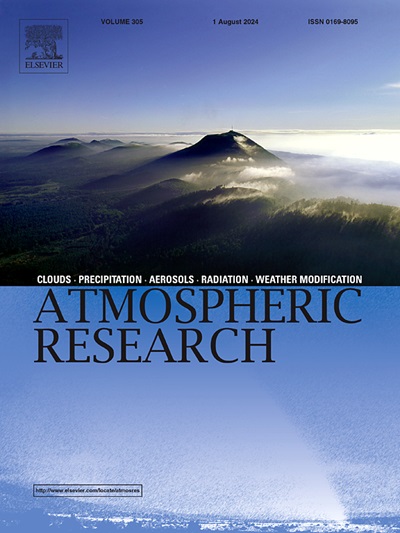Unveiling the vertical dynamics of atmospheric ammonium in Asia megacity: A GRASP-based investigation of spatiotemporal patterns and source drivers
IF 4.5
2区 地球科学
Q1 METEOROLOGY & ATMOSPHERIC SCIENCES
引用次数: 0
Abstract
Atmospheric ammonium (NH₄+), a key component formed through complex chemical reactions and particulate transformations involving nitrogen oxides (NOₓ) and ammonia (NH₃), plays a critical role in climate dynamics, ecological balance, and human health. Understanding the vertical distribution of NH₄+ is essential for comprehensively characterizing regional aerosol patterns. However, the lack of systematic and spatiotemporally resolved studies has hindered the development of accurate NH₄+ distribution models and predictive capabilities. In this study, we present an innovative algorithm based on the GRASP model to retrieve hourly NH₄+ mass concentration data from 2021 to 2022, enabling a detailed investigation of NH₄+ vertical distribution characteristics in Asia super megacity-Beijing. Our findings reveal that transportation emissions are a primary source of NH₄+ in Beijing, while elevated pollution sources and long-range transport also significantly influence local NH₄+ distribution. The vertical profiles exhibit strong seasonal consistency over the two-year study period, with higher concentrations typically observed in upper atmospheric layers compared to near-surface layers, and distinct peaks at 1 km and 300 m above ground level. NH₄+ concentrations are highest in spring and lowest in winter. In spring, the influence of northern dust leads to elevated NH₄+ levels, particularly on moderately polluted days, with more pronounced vertical gradients. During autumn, a significant peak in NH₄+ concentration at 1 km altitude is attributed to long-range transport from southern urban centers. The contribution of NH₄+ to PM₂.₅ remains relatively stable over the two years, with a slight increase during polluted hours due to enhanced hygroscopicity of NH₄+ particles driven by higher atmospheric humidity. Strong correlations among chemical components across various altitudes indicate a high degree of homogeneity. Additionally, ammonium nitrate (NH₄NO₃) is identified as the predominant form of NH₄+ in Beijing during the study period. These insights advance our understanding of NH₄+ dynamics and its role in urban air quality, providing a foundation for improved aerosol modeling and pollution mitigation strategies.
揭示亚洲特大城市大气铵的垂直动态:基于grasp的时空格局和源驱动因素研究
大气铵(NH₄+)是通过氮氧化物(NOₓ)和氨(NH₃)的复杂化学反应和颗粒转化形成的关键成分,在气候动力学、生态平衡和人类健康中起着关键作用。了解nh4 +的垂直分布对全面表征区域气溶胶模式至关重要。然而,缺乏系统和时空分辨率的研究阻碍了准确的nh4 +分布模型和预测能力的发展。在这项研究中,我们提出了一种基于GRASP模型的创新算法,用于检索2021 - 2022年每小时nh4 +质量浓度数据,从而详细研究亚洲超级大城市-北京的nh4 +垂直分布特征。研究结果表明,交通排放是北京地区NH₄+的主要来源,而污染源的升高和远距离运输对当地NH₄+的分布也有显著影响。在两年的研究期间,垂直剖面表现出强烈的季节性一致性,与近地表相比,在高层大气中观测到的浓度通常更高,在离地面1公里和300米处有明显的峰值。nh4 +浓度春季最高,冬季最低。在春季,北方沙尘的影响导致nh4 +水平升高,特别是在中度污染的日子,垂直梯度更明显。在秋季,nh4 +浓度在海拔1公里处出现显著峰值,这归因于来自南部城市中心的远距离输送。nh4 +对PM₂的贡献。在两年内,₅保持相对稳定,由于更高的大气湿度驱动NH₄+颗粒的吸湿性增强,在污染时间内会略有增加。不同海拔地区的化学成分之间存在很强的相关性,表明其具有高度的同质性。此外,在研究期间,硝酸铵(NH₄NO₃)被确定为NH₄+在北京的主要形式。这些见解促进了我们对nh4 +动力学及其在城市空气质量中的作用的理解,为改进气溶胶建模和污染缓解策略提供了基础。
本文章由计算机程序翻译,如有差异,请以英文原文为准。
求助全文
约1分钟内获得全文
求助全文
来源期刊

Atmospheric Research
地学-气象与大气科学
CiteScore
9.40
自引率
10.90%
发文量
460
审稿时长
47 days
期刊介绍:
The journal publishes scientific papers (research papers, review articles, letters and notes) dealing with the part of the atmosphere where meteorological events occur. Attention is given to all processes extending from the earth surface to the tropopause, but special emphasis continues to be devoted to the physics of clouds, mesoscale meteorology and air pollution, i.e. atmospheric aerosols; microphysical processes; cloud dynamics and thermodynamics; numerical simulation, climatology, climate change and weather modification.
 求助内容:
求助内容: 应助结果提醒方式:
应助结果提醒方式:


